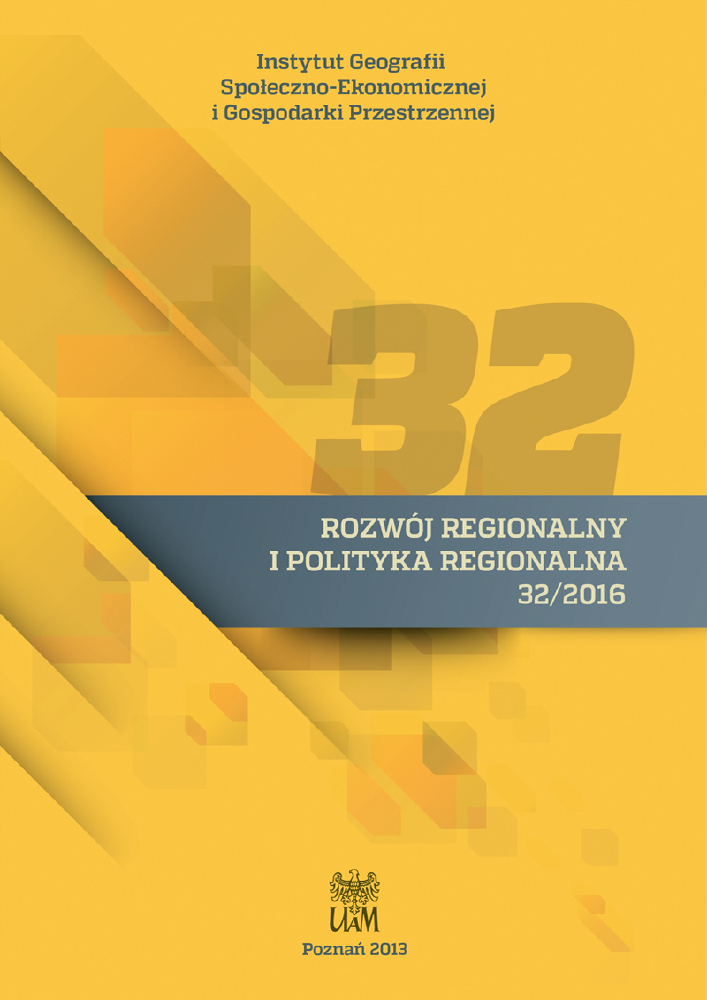Abstract
The article presents the use of Shannon entropy statistics and algorithm developed by Semple and Gauthier in the study of changes in the Polish regional differences. The assessment of the cognitive value of this method due to the possibility of analyzing the relationship between inter- and intraregional inequalities is shown.References
Batty M. 2010. Space, scale, and scaling in entropy maximizing. Geographical Analysis, 42: 395–421. DOI: https://doi.org/10.1111/j.1538-4632.2010.00800.x
Blakely E.J., Bradshaw T.K. 2002. Planning local economic development. Theory and practice. Sage Publication, Thousand Oaks.
Czyż T. 2002. Zastosowanie modelu potencjału w analizie zróżnicowania regionalnego Polski. Studia Regionalne i Lokalne, 2–3: 5–14.
Czyż T. 2012. Poziom rozwoju społeczno-gospodarczego Polski w ujęciu subregionalnym. Przegląd Geograficzny, 84, 2: 219–236. DOI: https://doi.org/10.7163/PrzG.2012.2.3
Czyż T., Hauke J. 2015. Spatial entropy in regional analysis. Quaestiones Geographicae, 34(4): 30–47. DOI: https://doi.org/10.1515/quageo-2015-0037
De la Fuente A. 2002. On the sources of convergence: a close look at the Spanish regions. European Economic Review, 46(3): 569–599. DOI: https://doi.org/10.1016/S0014-2921(01)00161-1
Domański R. 2012. Ewolucyjna gospodarka przestrzenna. Wydawnictwo Uniwersytetu Ekonomicznego
w Poznaniu, Poznań.
European Commision EU 2014. Investment for jobs and growth. Promoting development and good governance in EU regions and cities. Six report on economic, social and territorial cohesion. Region
and Urban Commission, Brussels.
Ezcurra R. 2007. In income inequality harmful for regional growth? Evidence from the European Union,. Urban Studies, 44, 10: 1953–1971. DOI: https://doi.org/10.1080/00420980701471877
Gauthier H.L., Semple R.K. 1974. Trends in regional inequalities in the Brazilian economy 1947–1966. [W:] R.S. Thoman (red.), Methodology and case studies. Vol. I. Proceedings of the Commission
on Regional Aspects of Development of the IGU. Hayword, California, USA, s. 249–266.
Kudrycka I. 2014. Analiza konwergencji rozwoju regionalnego w Polsce w latach 2001–2012. Acta Universitatis Lodziensis. Folia Oeconomica, 6: 51–66.
Semple R.K., Gauthier H.L. 1972. Spatial-temporal trends in income inequalities in Brasil. Geographical DOI: https://doi.org/10.1111/j.1538-4632.1972.tb00467.x
Analysis, 2: 189–179.
Shannon C.E. 1948. A mathematical theory of communication. Bell System Technical Journal, 27: 379–423, 623–656. DOI: https://doi.org/10.1002/j.1538-7305.1948.tb00917.x
Shannon E., Weaver W. 1949. The mathematical theory of communication, University of Illinois Press, Urbana, Illinois.
Szlachta J. 2013. Europejskie uwarunkowania trzeciej generacji strategii rozwoju regionalnego w Polsce – poziom województw. KPZK PAN, Studia, CLV, Warszawa.
Werner P., Korcelli P., Kozubek E. 2014. Population potential as a modulator of land use changes in Poland’s metropolitan areas. Quaestiones Geographicae, 33(2): 37–50. DOI: https://doi.org/10.2478/quageo-2014-0014
Wędrowska E. 2010. Wykorzystanie entropii Shannona i jej uogólnień do badania rozkładu prawdopodobieństwa DOI: https://doi.org/10.59139/ps.2010.04.4
zmiennej losowej dyskretnej. Przegląd Statystyczny, LVII, 4: 39–53.
Wędrowska E. 2012. Miary entropii i dywergencji w analizie struktur. Wydawnictwo UWM, Olsztyn.
Wilson A.G. 1967, A statistical theory of spatial distribution models. Transport Research, 1: 253–269. DOI: https://doi.org/10.1016/0041-1647(67)90035-4
Wilson A.G. 1970. Entropy in urban and regional modelling. Pion Press, London.
Wilson A.G. 2010. Entropy in urban and regional modeling: retrospect and prospect. Geographical Analysis, 42: 364–394. DOI: https://doi.org/10.1111/j.1538-4632.2010.00799.x
License
Copyright
© 2015 IGSEiGP, Uniwersytet im. Adama Mickiewicza w Poznaniu
OPEN ACCESS
